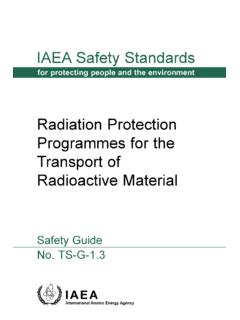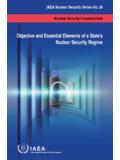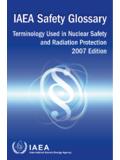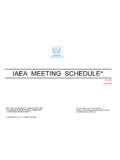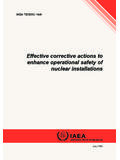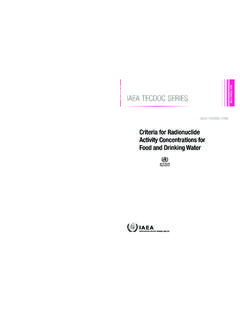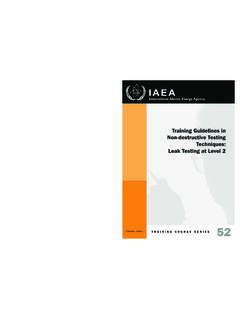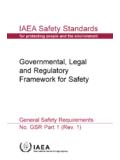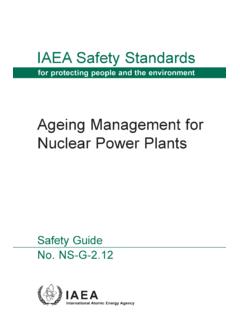Transcription of HUMAN ERROR CLASSIFICATION AND DATA COLLECTION
1 IAEA-TECDOC-538. HUMAN ERROR CLASSIFICATION . AND DATA COLLECTION . REPORT OF A TECHNICAL COMMITTEE MEETING. ORGANIZED BY THE. INTERNATIONAL ATOMIC ENERGY AGENCY. AND HELD IN VIENNA, 20-24 FEBRUARY 1989. A. TECHNICAL DOCUMENT ISSUED BY THE. INTERNATIONAL ATOMIC ENERGY AGENCY, VIENNA, 1990. Ti>e ' AHA does not normally maintain stocks of reports in this series. However, microfiche copies of these reports can be obtained from l h IS Clearinghouse Internationa! Atomic Energy Agency VVagramerstrasse 5. Box 100. A-1400 Vienna, Austria Orders should be accompanied by prepayment of Austrian Schillings 100, an the form of 3 cheque or in the form of IAEA microfiche service coupons whicrs may be ordered separately from the INIS Clearinghouse, HUMAN ERROR CLASSIFICATION AND DATA COLLECTION . IAEA, VIENNA, 1990. IAEA-TECDOC-538. ISSN 1011-4289. Printed by the IAEA in Austria January 1990. EDITORIAL NOTE. In preparing this material for the press, staff of the International Atomic Energy Agency have mounted and paginated the original manuscripts as submitted by the authors and given some attention to the presentation.
2 The views expressed in the papers, the statements made and the general style adopted are the responsibility of the named authors. The views do not necessarily reflect those of the governments of the Member States or organizations under whose auspices the manuscripts were produced. The use in this book of particular designations of countries or territories does not imply any judgement by the publisher, the IAEA, as to the legal status of such countries or territories, of their authorities and institutions or of the delimitation of their boundaries. The mention of specific companies or of their products or brand names does not imply any endorsement or recommendation on the part of the IAEA. Authors are themselves responsible for obtaining the necessary permission to reproduce copyright material from other sources. PLEASE BE AWARE THAT. ALL OF THE MISSING PAGES IN THIS DOCUMENT. WERE ORIGINALLY BLANK.
3 CONTENTS. 1. HUMAN ERROR CLASSIFICATION AND DATA COLLECTION - GENERAL .. 9. Introduction .. 9. General objectives of HUMAN ERROR CLASSIFICATION and data COLLECTION .. 10. HUMAN ERROR CLASSIFICATION .. 10. Data COLLECTION .. 11. Interaction of HUMAN ERROR CLASSIFICATION and data COLLECTION .. 12. Specific objectives of HUMAN ERROR CLASSIFICATION and data COLLECTION .. 12. Current situation .. 14. General remarks/possible ways forward .. 15. 2. QUALITATIVE DATA COLLECTION AND CLASSIFICATION .. 17. Introduction .. 17. Data requirements .. 17. Why qualitative HUMAN ERROR data should be collected .. 17. Plants .. 18. Researchers .. 19. Community/authorities .. 20. Data limitations .. 21. Factual information .. 22. Information based on subsequent analysis and judgement .. 23. COLLECTION .. 23. CLASSIFICATION .. 24. Feedback of data .. 24. Promotion of plant specific HUMAN ERROR reporting .. 25. Management culture.
4 25. Safety awareness training of plant staff .. 26. Repeated management actions to promote reporting .. 26. Organization of reporting system .. 27. Benefit from the reporting system .. 28. Recommendations .. 29. 3. QUANTITATIVE DATA COLLECTION AND CLASSIFICATION .. 31. Introduction .. 31. Data and techniques .. 31. Technique for HUMAN ERROR rate prediction (THERP) .. 32. Accident sequence evaluation programme (ASEP) .. 32. HUMAN cognitive reliability correlation (HCR) .. 33. Maintenance personnel performance simulation (MAPPS) .. 33. Operational action tree (OAT) .. 34. Success likelihood index methodology (SLIM) .. 35. Socio-technical approach (STAHR) .. 35. Possible data sources .. 35. Nuclear power plant experience .. 36. Use of simulators .. 36. Expert opinion .. 37. Conclusions and recommendations .. 37. AxCtual situation .. 37. Suggested future improvements .. 38. 4. PROPOSAL FOR A CO-ORDINATED RESEARCH PROGRAMME.
5 40. Co-ordinated research programme .. 40. Overall objectives of the CRP .. 40. Research and discussion topics .. 41. Products of programme .. 42. APPENDIX 1. FACTORS AFFECTING HUMAN PERFORMANCE .. 43. ANNEX. PAPERS PRESENTED AT THE MEETING. SSPB activities on analyzing HUMAN performance problems .. 47. L. Jacobsson An approach to HUMAN ERROR minimization in PHWR safety related operations .. 51. G. Govindarajan HUMAN errors HUMAN caused, environment caused .. 61. K. C. Subramanya HUMAN reliability data COLLECTION for qualitative modelling and quantitative assessment .. 71. Lucas, Embrey, Livingston COLLECTION , analysis and CLASSIFICATION of HUMAN performance problems at the Swedish nuclear power plants .. 83. Bento HUMAN characteristics affecting nuclear safety .. 95. M. Skof HUMAN reliability models validation using simulators .. 103. M. de Aguinaga, A. Garcia, J. Nunez, A. Prades Outline of the development of a nuclear power plant HUMAN factor data base.
6 Ill A. Kameda, T. Kabetani HUMAN ERROR CLASSIFICATION and data COLLECTION survey in an Indian nuclear power plant .. 127. N. Rajasabai, V. Rangarajan, Murthy Possibilities and necessity of the HUMAN ERROR data COLLECTION at the Paks nuclear power plant .. 141. T. Szikszai Higher operational safety of nuclear power plants by evaluating the behaviour of operating personnel .. 147. M. Mertins, P. Glasner HUMAN reliability data sources applications and ideas .. 155. P. Pyy, U. Pulkkinen, Vaurio List of Participants .. 169. 1. HUMAN ERROR CLASSIFICATION AND DATA COLLECTION - GENERAL. Introduction Awareness of HUMAN factors and HUMAN reliability has increased significantly over the last 10 to 15 years primarily due to major catastrophes that have had significant HUMAN ERROR contributions, Three Mile Island, Challenger space shuttle, Chernobyl. Each of these and other incidents have identified different types of HUMAN errors and failings; some of which were not generally recognized prior to the incident.
7 Due to the results of these events it has been widely recognized that more information about HUMAN actions and errors is needed to improve safety and operation of nuclear power plants. For a long time the Fault Assessment/Reliability world realized it needed data on component and system failures and created schemes for collecting suitable data. Probabilistic Safety Assessment (PSA) studies have started to incorporate HUMAN actions and errors ; PSA specialists are now demanding HUMAN reliability data to incorporate within PSA models. The initial attempts to collect HUMAN reliability and ERROR data were to review existing plant data COLLECTION schemes and extend their coveraya to identify failures due to HUMAN errors . Recently schemes have been started that are dedicated solely to the COLLECTION of HUMAN ERROR data, or the analysis of HUMAN performance related plant events, the Institute for Nuclear Power Operations' HUMAN Performance Evaluation System.
8 (INPO's HPES). Analysis of HUMAN ERROR data requires HUMAN ERROR CLASSIFICATION . As the HUMAN factors/reliability subject has developed so too has the topic of HUMAN ERROR CLASSIFICATION . The classifications vary considerably depending on whether it has been developed from a theoretical psychological approach to understanding HUMAN behavior or ERROR , or whether it has been based on an empirical practical approach. This latter approach is often adopted by nuclear power plants that need to make practical improvements as soon as possible. This document will review aspects of HUMAN ERROR CLASSIFICATION and data COLLECTION in order to show where potential improvements could be made. It will attempt to show why there are problems with HUMAN ERROR CLASSIFICATION and data COLLECTION schemes and that these problems will not be easy to resolve. General Objectives of HUMAN ERROR CLASSIFICATION and Data COLLECTION There are a variety of general objectives for HUMAN ERROR CLASSIFICATION and data COLLECTION .
9 The three obvious overall objectives are: I. to provide qualitative improvements to plant safety, identification of HUMAN ERROR problems and introduction of measures to reduce or prevent those HUMAN errors that are related to safety;. II. to provide qualitative improvements to plant performance/availability, identification of HUMAN ERROR problems and introduction of iseasures to reduce or prevent those errors that affect plant performance/availability;. III. to provide numerical data for use in PSAs or other safety studies. These are discussed in greater detail in Section of this report ,1 HUMAN ERROR CLASSIFICATION There are many different HUMAN ERROR classifications, which are being generated to assist, analysis of HUMAN ERROR and behavior. Hence the classifications are dependent on the objectives of the analyst. A psychologist may be interested in understanding the psychological causes of a HUMAN ERROR to compare with a theoretical model.
10 A nuclear power plant engineer will want to classify HUMAN errors in a way that enables practical ERROR reduction steps to be taken quickly. In both cases the HUMAN ERROR CLASSIFICATION allows HUMAN ERROR data to be handled and "root causes" to be classified. However, there is likely to be considerable variance on what each classes as a "root cause". The plant engineer may well define root causes along a practical basis, 10. deficient procedures, lack of training. A psychologist may prefer to use "root causes" related to a theoretical psychological model of HUMAN behaviour, Rasmussen's skill-rule-knowledge triangle. The Generic ERROR Modelling System (GEMS) is an example of such a HUMAN ERROR CLASSIFICATION . An example of a more practically based system used in India is presented in one of the papers given in the Annex. In all cases the HUMAN ERROR CLASSIFICATION is used to assist the analyst to achieve his or her own objectives.
